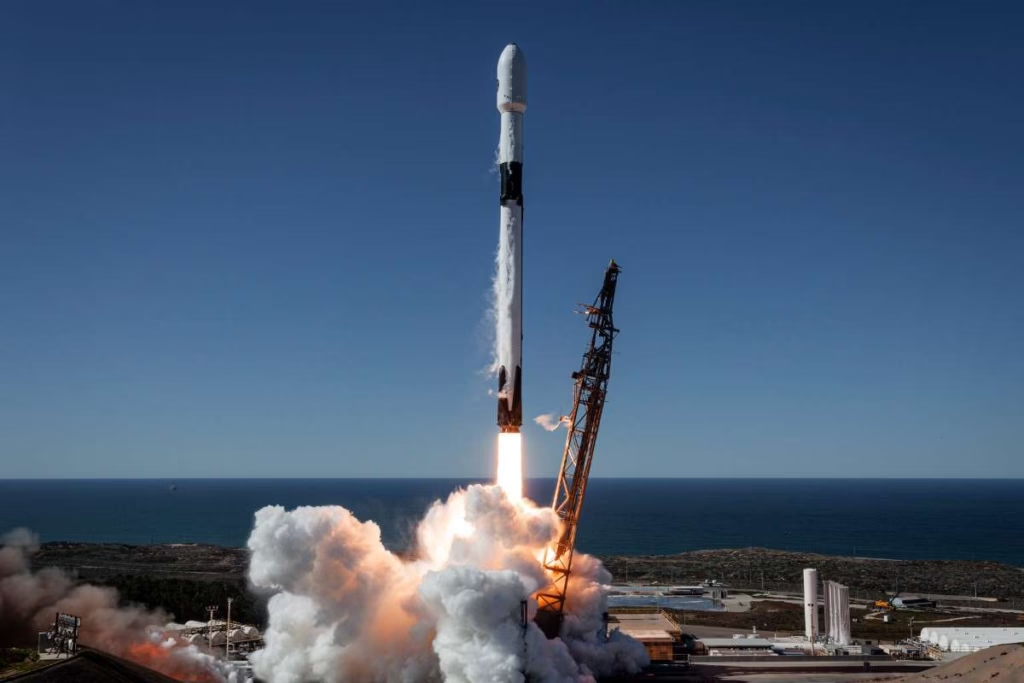Falcon 9 to Launch USSF‑178 Mission for the U.S. Space Force, deploying the DoD’s next-gen weather satellite and BLAZE‑2 prototypes. Learn how this mission advances military space strategy.

Falcon 9 to Launch USSF‑178 Mission: Enhanced Space Military strength
SpaceX is preparing to launch its Falcon 9 rocket today on behalf of the United States Space Force—a mission officially designated USSF‑178. This launch marks another significant milestone for military and scientific satellite deployment, carrying two critical payload types:
- A next-generation weather surveillance spacecraft built for the Space Systems Command, and
- The BLAZE‑2 constellation—a network of small prototype satellites designed for operational research and development.
Below is a thorough overview of the USSF‑178 mission, the payloads on board, SpaceX’s role, and the mission’s relevance to national security and space innovation.
1. Falcon 9 to Launch USSF‑178 Mission: What Is USSF‑178?
Falcon 9 to Launch USSF‑178 Mission is a multi-manifest launch operated by SpaceX under contract with the U.S. Space Force. Managed by Space Systems Command (SSC), this launch delivers essential technology for weather monitoring and defense experiments. It demonstrates the growing reliance on small and medium-class satellites to enhance situational awareness on and off Earth.
2. Launch Vehicle: Falcon 9
Falcon 9, SpaceX’s workhorse, is the rocket of choice for USSF‑178. Known for its reusable first stage, orbital precision, and rapid turnaround, Falcon 9 delivers reliable access to space for both government and commercial customers. For this mission, SpaceX plans to recover the first stage after landing on one of its droneships.
Falcon 9’s track record includes numerous successful launches of spacecraft ranging from GPS satellites to crewed Dragon missions. Its versatility continues to make it a top choice for military payloads.
3. Primary Payload: Space Systems Command Next-Gen Weather Satellite
3.1 Mission Overview
The main payload aboard USSF‑178 is a new weather system space vehicle developed by Space Systems Command. Though its official designation remains under wraps, sources suggest that it will be among the most advanced weather monitoring satellites in the U.S. defense portfolio.
3.2 Key Features
- High-resolution imaging for real-time storm tracking and atmospheric observation
- Ability to collect data on severe weather—like hurricanes, solar events, and space weather
- Integration with the DoD’s weather data architecture to provide actionable information for military and civilian use
By launching this asset, the military hopes to enhance global weather monitoring capabilities, improving mission planning and humanitarian response.
4. Secondary Payloads: BLAZE‑2 Prototype SmallSats
4.1 Introducing BLAZE‑2
The USSF‑178 mission also carries the BLAZE‑2 constellation—a package of small prototype satellites designed to test new technologies in space. These SmallSats will collect data that could influence future defense and communications systems.
4.2 The Purpose of BLAZE‑2
- Hardware and software experimentation in orbit, including as-yet-unreleased tech
- Operational resilience testing in varied orbital and environmental conditions
- Gathering performance data to inform subsequent generations of military space hardware
This mission represents a growing trend toward rapid prototyping and deployment in space, reducing the time needed to transition ideas into orbit.
5. Strategic Military and National Security Implications
Falcon 9 to Launch USSF‑178 Mission
5.1 Enhanced Weather Awareness
The new weather satellite will provide real-time environmental data critical to military planning and humanitarian missions.
5.2 Accelerated Defense R&D
With BLAZE‑2, the U.S. Space Force is embracing agile development, aiming to test and iterate technologies in orbit before full production.
5.3 Supporting Future DoD Missions
The success of this launch signals strong commitment to maintaining a cutting-edge space architecture that combines resiliency, speed, and technological superiority.
6. Falcon 9 to Launch USSF‑178 Mission: The Launch Timeline
- Launch Complex: Falcon 9 will lift off from a SpaceX facility on the U.S. Eastern Seaboard, south of Cape Canaveral.
- Launch Window: A multi-hour window opens today, selected to meet orbital insertion requirements.
- Stage Separation: After approximately two minutes, the first stage will detach and glide to a drone ship landing.
- Second Stage Burn: Continues toward orbital destination before deploying payloads.
- Deployment Sequence: The weather spacecraft is expected to separate first, followed by BLAZE‑2 satellites in a planned deployment sequence.
7. Falcon 9 to Launch USSF‑178 Mission: How Falcon 9 Recovers Its Boosters
Reconquering the first stage is a hallmark of Falcon 9 operations:
- Stage Separation: Once main booster engines shut off, the first stage performs a flip maneuver.
- Boostback and Re-entry Burn: Ensures precise coast and reentry into Earth’s atmosphere.
- Landing Burn: Final deceleration allowing a soft touchdown on SV “A Shortfall of Gravitas” or “Of Course I Still Love You.”
- Recovery and Refurbishment: The mission will be added to the Falcon 9 booster’s flight history if recovered successfully.
This reusability model significantly reduces launch costs and accelerates mission cadence.
8. Broader Context: DoD’s Shift in Space Strategy
8.1 Small Satellite Growth
The DoD is increasingly adopting small satellite platforms to support responsive, agile space capabilities.
8.2 Prototyping in Orbit
Initiatives like BLAZE‑2 support a shift toward operational experimentation, testing new hardware and software in space for real-world evaluation.
8.3 Public–Private Partnership
By leveraging SpaceX’s reusable rockets, the DoD can accelerate deployment and reduce costs while focusing on mission objectives rather than launch logistics.
9. Falcon 9 to Launch USSF‑178 Mission: What to Watch After Launch
- First-Stage Recovery: Determine if Falcon 9 booster lands successfully
- Payload Health: Space Force confirmation of satellite tracking and systems tests
- Mission Updates: Over coming days, the DoD and SpaceX will confirm successful deployments
These are validated via telemetry, ground station reports, and possibly later press releases or congressional updates.
10. Falcon 9 to Launch USSF‑178 Mission: What Happens After Payload Deployment
10.1 Spacecraft Activation
- The weather spacecraft and BLAZE‑2 satellites initiate systems checks
- Sun-pointing, thermal cycling, and communications link establishment
10.2 Early Operations
The weather satellite will begin data collection within days. The BLAZE‑2 satellites will log test parameters and may remain active for weeks or months as they experiment in orbit.
10.3 Long-Term Roadmap
If successful, BLAZE prototype data may feed into future satellite programs and influence the design of larger constellations or updated defense platforms.
11. Falcon 9’s Proven Capability
Since its debut in 2010, Falcon 9 has flown over 200 missions, including GPS, Starlink, Defense Support Program, and Crew Dragon. Its 100+ successful recoveries underline its reliability. The USSF‑178 mission is another confirmation of Falcon 9’s capacity to deliver multi-payload missions with precision and persistence.
12. Implications for SpaceX and the DoD
12.1 Budgetary Efficiency
Reusable rockets lower launch costs, freeing military funding for additional capabilities.
12.2 Mission Speed
SpaceX’s rapid launch cadence allows DoD to plan responsive schedules and revise mission architecture more dynamically.
12.3 Technological Edge
Deploying weather and prototype hardware strengthens the national space posture in both civil and defense contexts.
13. Future DoD–SpaceX Collaborations
The USSF‑178 mission builds on previous Space Force launches like NROL-class insertions and secret payload missions. Future efforts may involve:
- Larger payloads or classified systems
- Rapid-response missions
- Fleet replenishment capabilities
The Space Force goal is to align with commercial innovation and leverage private infrastructure for defense gains.
14. Falcon 9 to Launch USSF‑178 Mission: What This Means for Space Innovation
This mission reflects several long-term trends:
- A shift toward rapid prototyping in orbit
- Increased use of small satellites for resilience and coverage
- Public–private partnerships as the backbone of military and civilian space efforts
USSF‑178 pushes the conversation from exploration to integration and operations—space as a functional warfighting domain as much as a frontier.
15. Falcon 9 to Launch USSF‑178 Mission: Final Takeaways
- USSF‑178 brings high-value weather data and experimental payloads to orbit on a single launch
- April–June cadence demonstrates the Space Force’s growing reliance on smallsat platforms
This mission stands at the nexus of tech, national security, and commercial progress—q uietly redefining how military space operations are conducted.
News Source:-
https://x.com/SpaceX/status/1938758049000497466?t=MnJCuRVh1HkbsLwEtr5cmg&s=19
Falcon 9 to Launch USSF‑178 Mission FAQs: Falcon 9 Launch for the U.S. Space Force
Q1. What is the USSF‑178 mission?
A: USSF‑178 is a multi-payload satellite mission launched by SpaceX’s Falcon 9 rocket for the U.S. Space Force. It includes a new weather system space vehicle for Space Systems Command and BLAZE‑2, a set of small prototype satellites for experimental research and development in orbit.
Q2. Who is managing the mission?
A: The mission is managed by Space Systems Command (SSC), a division of the U.S. Space Force responsible for developing and delivering resilient space capabilities to warfighters.
Q3. What rocket is being used for this mission?
A: SpaceX’s Falcon 9 rocket is being used. It is a two-stage, partially reusable orbital launch vehicle known for its precision, cost-efficiency, and high reliability.
Q4. What is the purpose of the weather system space vehicle?
A: The weather satellite will provide advanced monitoring of global weather patterns, including storm activity, atmospheric conditions, and space weather. It supports both military planning and civil emergency response efforts.
Q5. What is BLAZE‑2?
A: BLAZE‑2 is a set of prototype small satellites designed to test new hardware, software, and communication technologies in orbit. These tests will help inform future Department of Defense satellite missions and architectures.
Q6. Why is this mission important to national defense?
A: It supports faster prototyping, more responsive satellite deployment, and enhanced weather intelligence—all of which are critical for military operations, global awareness, and technological advancement in contested environments.
Q7. Where is the launch taking place?
A: The Falcon 9 launch is scheduled to lift off from Cape Canaveral Space Launch Complex, located on the eastern coast of Florida.
Q8. Will the Falcon 9 booster be recovered?
A: Yes, SpaceX intends to recover the Falcon 9’s first stage booster using a droneship landing at sea. This supports SpaceX’s goal of reusability and cost-effective space access.
Q9. How are the satellites deployed during the mission?
A: After liftoff, the rocket’s upper stage reaches the intended orbit, and the weather satellite is deployed first, followed by sequential release of the BLAZE‑2 satellites.
Q10. What happens after deployment?
A: The satellites will undergo system checks and calibration. The weather satellite will begin atmospheric data collection, while the BLAZE‑2 units will run various tests for performance evaluation in the space environment.
Q11. How does this mission fit into Space Force strategy?
A: It aligns with the U.S. Space Force’s strategy of developing resilient, flexible, and fast-to-deploy space assets that support military readiness and global operations.
What Is Rocket Labs Symphony In The Stars ? Everything About Today’s Big Launch
